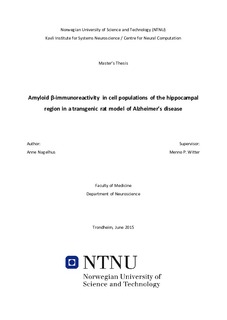| dc.description.abstract | Alzheimer’s disease (AD) is one of the most devastating neurodegenerative disorders and the most common cause of dementia in the elderly. Both amyloid β (Aβ) and tau pathology show a characteristic spatiotemporal progression throughout the brain. In particular, parts of the hippocampal formation (HF) and parahippocampal region (PHR), which are involved in memory and spatial processing, are heavily affected in early stages. By the time the clinical symptoms of AD start to manifest, the neuropathological changes in the brain are severe, and it is thus vital to identify cell types that are vulnerable to early pathology. With use of the transgenic McGill-R-Thy1-APP rat model, which faithfully mimics human Aβ pathology, this thesis aimed to determine whether neuronal populations in HF and PHR that accumulate intracellular Aβ (iAβ) in the pre-plaque stage of AD are characterised by the presence of distinct molecular markers. The first part focused on a subset of principal neurons in layer II of entorhinal cortex (EC) that express the glycoprotein reelin and project to HF. By doing immunohistochemical double-labelling and unbiased stereology, we found that reelin-positive principal cells in layer II of both lateral and medial EC are heavily immunoreactive to iAβ in the pre-plaque stage in homozygous McGill-R-Thy1-APP rats. Reelin is important for synaptic plasticity and is believed to be involved in dysfunction associated with AD, and accumulation of iAβ in the reelin-expressing population of principal cells in layer II of EC could have important effects on plasticity in the entorhinal-hippocampal network. A subset of calbindin-positive cells in medial EC layer II were also found to express iAβ. In view of the importance of interneurons in network functionality, in the second part of this thesis we investigated whether iAβ is also expressed in interneurons in early stages of disease in homozygous McGill-R-Thy1-APP rats. Immunohistochemical double-labelling showed that interneurons in all subareas of HF and PHR express iAβ at the pre-plaque stage. iAβ was found in subsets of both parvalbumin- and somatostatin-positive interneurons. Due to early amyloid pathology in subiculum and its reciprocal connections with EC, we counted iAβ-positive interneurons in this area and found that a significantly larger proportion of interneurons in dorsal and intermediate regions of subiculum were immunoreactive to iAβ than in ventral regions. Taken together, the results of this thesis suggest that iAβ is expressed in a large number of principal cells and interneurons at early ages in the McGill-R-Thy1-APP rat model of AD, and that these cells are heterogeneous with regards to their neurochemical profiles. The finding that both principal cells and interneurons are affected heavily by iAβ in HF and PHR supports the already established idea that AD not only affects single cells or synapses, but also local assemblies and larger networks of neurons. | nb_NO |
